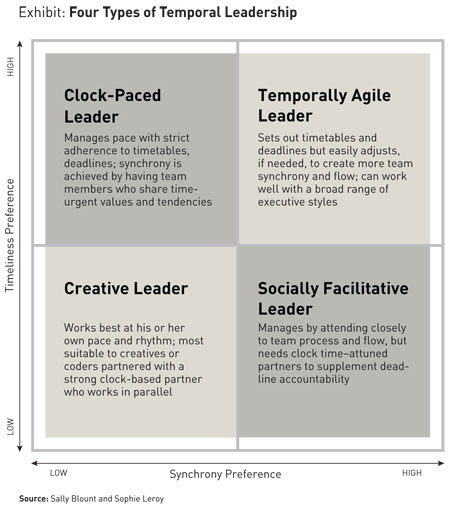The following is a guest piece by Sally Blount, Dean of the Kellogg School of Management, and Sophie Leroy, assistant professor at University of Washington’s Bothell’s School.
CEO tenure in the Fortune 500 has fallen from an average of 11 years in 2002 to six years today. The average life span of a company in the Fortune 500 has shrunk from 25 years in 1980 to just 15 today. The end result is a pervasive sense of anxiety and time famine, as both companies and the executives within them struggle to keep up.
But speed and urgency, although necessary attributes of leadership, are not sufficient. In fact, our research suggests that the leaders who can tether an obsession with deadlines and time to an ability to sense the work and energy flow of their colleagues will have the most success.
Cultural anthropologists were the first to recognize that people tend to track time in two ways: clock time and social time. Under clock time, punctuality and predictability are highly valued. People adhere strictly to deadlines and appointment times.
Under social time, by contrast, conversational and relational smoothness and the ability to complete a thought or interaction without abruptness are valued. A fluid sense of natural rhythm in conversations and interactions over time enhances relationship building.
Research found that, traditionally, southern European and Latin cultures placed more emphasis on social time and Anglo-Saxon cultures placed more emphasis on clock time. But these cultural differences are beginning to wane as more of the world moves to a global business culture driven by clock time. Still, within the same culture, research has long found significant differences in how people experience time.
The Importance of Flow
The most established psychological measure of differences in how people track time is known as time urgency. Highly time-urgent people monitor clocks and watches frequently and place an implicit value on efficient time usage. They adhere tightly to schedules, lists, and deadlines; they place a value on punctuality.
In our research over the last 10 years, we’ve been exploring the existence of a second dimension to how humans track time, inspired by the cultural differences in time perception that anthropologists have observed and work by psychologist Mihaly Csikszentmihaly and others on the concept of flow.
We start with the idea that humans in groups like to experience a sense of social synchrony, which we define as alignment in how people perceive and adapt to create a sense of relational smoothness and flow in interaction.
In a recent paper we published in Personnel Psychology, completed with coauthors Abbie Shipp and John-Gabriel Licht, we showed that even within cultures, people vary widely in the degree to which they notice synchrony in their interactions. What’s more, they vary in their willingness to adapt their own pace in order to better align with others’ pace.
We call the willingness and proclivity to adapt the synchrony preference. The synchrony preference captures the degree to which a person tracks the pace of other people’s behavior and is willing to adapt his or her own behavior to match it, in terms of both speeding up and slowing down.
Some examples of the socio-temporal cues people might use to indicate aligned pace include the gentle nodding of one’s head and short expressions of “yes” and “that’s right.” When one wants to speed up another person, one may look at one’s watch or express anxiety about taking up others’ time. Similarly, to slow things down, one may say “let me stop you there for a minute” or subtly put up one’s hand.
In general, people who score high on synchrony preference are more likely to notice and incorporate these types of cues into their own mental processing and behavior. By contrast, people who rate low on synchrony preference place more value on maintaining their own rhythm or pace in interaction and tend to ignore social cues that might deter them.
And when they do align on pace, it is often because they make a point of filling their teams with people who have similar pacing preferences. We have found repeatedly in our own and others’ research that people tend to like coworkers with whom they feel naturally aligned on pace. Pace alignment is often what people feel when they express feeling “flow” or smoothness in an interaction.
In this study, for the first time, we have been able to link the synchrony preference to improved work performance. People who rate high on synchrony preference not only notice differences in pace with others, but are able to adjust their own behaviors and collaborate more effectively with others in the process.
This flexibility is clearly important in a world where constant reinvention is required; where getting things done depends on teamwork and collaboration; and where management, more often than not, crosses countries and cultures.
The Synchronous Leader
People who score high on both synchrony preference and time urgency tend to be better liked, and their contributions are more valued in team settings. They are also more likely to hold leadership positions within their teams.
Further, controlling for national culture, we found that executives with high synchrony scores tend to view and experience themselves as interdependent with others, rather than independent, and are more open to new information and experiences and more amenable to multitasking.
These findings show that although effective leaders must be able to keep their teams on schedule and manage time effectively in order to meet deadlines (something at which time-urgent individuals excel), they also need to facilitate interpersonal interactions within these schedules to help employees function as a team (something at which individuals high on synchrony preference excel).
We developed a framework for teaching executives about the importance of temporal perception in management (see exhibit). We’ve identified four temporal leadership types, depicting the degree to which a leader is high or low on both the preference for timeliness (the time urgency measure) and the preference for social synchrony. It also describes how important adhering to self-pacing versus group pacing is considered by different types of leaders.

The most successful leaders fall into the upper right quadrant (temporally agile leaders). Most striking, perhaps, our research suggests that a high score on timeliness is no longer enough to get to the C-suite. In fact, those who score high on timeliness but low on synchrony will find themselves limited in both roles and advancement in our high-speed culture.
Those who are able to combine timeliness and synchrony are more likely to affiliate with others and to help them effectively, and less likely to show dominance, autonomy, and impulsivity. They can exhibit give and take. And when a team is under stress, these leaders can pull back to allow team members the kind of breathing room that will lead to long-term resilience.
Sally Blount is dean and the Michael L. Nemmers Professor of Management and Organizations at the Kellogg School of Management at Northwestern University and a board member at Abbott Laboratories. Sophie Leroy is an assistant professor at the University of Washington Bothell’s School of Business. Previously, she was an executive at Interbrand and worked for PricewaterhouseCoopers and Société Générale.
Adapted and reprinted with permission from “Management Is All in the Timing” from strategy+business. © 2016 PwC. All rights reserved. PwC refers to the PwC network and/or one or more of its member firms, each of which is a separate legal entity. Please see www.pwc.com/structure for further details. www.strategy-business.com

